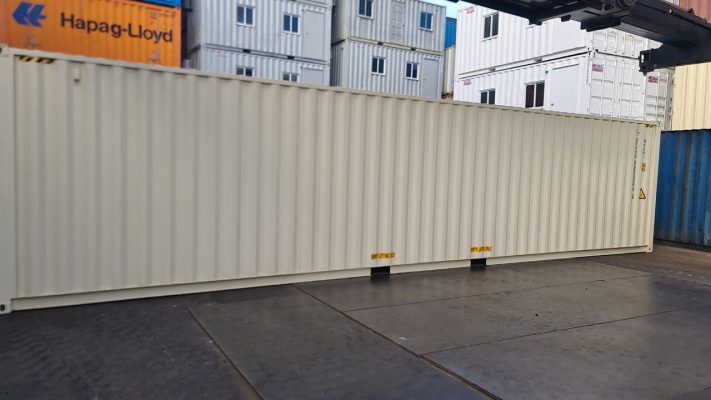The Environmental Impact of Shipping Containers: A Sustainable Option?

Shipping containers are everywhere in the modern world, serving as the backbone of global trade. But beyond their traditional role in transporting goods, these steel boxes have been repurposed into homes, offices, and even urban farms, raising questions about their environmental impact. Are shipping containers truly a sustainable option, or do their benefits come with hidden ecological costs?
The Lifecycle of a Shipping Container
To understand the environmental impact of shipping containers, it’s essential to break down their lifecycle, from manufacturing to potential reuse.
Manufacturing
Shipping containers are typically made from Corten steel, a durable material resistant to corrosion. While this makes them perfect for withstanding harsh weather conditions at sea, the manufacturing process is resource-intensive. Producing one ton of steel emits around 1.85 tons of CO2, contributing to global greenhouse gas emissions. Additionally, mining iron ore and coal—the primary materials used in steel production—can result in environmental degradation, including deforestation and soil erosion.
However, the longevity of shipping containers helps offset the initial environmental costs of production. A well-maintained container can last over 25 years, reducing the frequency of new manufacturing cycles compared to other structures.
Transportation and Usage
Shipping containers are primarily used to transport goods across oceans, railways, and highways. While container shipping itself contributes to global emissions, it is considered more energy-efficient compared to air freight. Shipping containers stack easily on cargo ships, maximizing space and reducing the overall number of trips needed to transport goods.
Once a container reaches the end of its shipping life, it often becomes surplus—either destined for scrap metal or left abandoned in storage yards. This is where their potential for reuse becomes environmentally significant.
Repurposing and Upcycling Shipping Containers
The concept of repurposing shipping containers for alternative uses has gained traction in recent years, particularly in the realms of architecture and sustainability. Old containers are now being transformed into homes, offices, retail spaces, and even farms. This practice taps into a core principle of sustainability: reducing waste by reusing materials.
Benefits of Repurposing
- Reduction of New Construction Materials: By reusing existing containers, there’s less demand for traditional construction materials like bricks, wood, and cement—all of which require significant energy to produce and transport. Shipping containers provide a ready-made structural framework, reducing both the financial and environmental costs of building from scratch.
- Minimizing Waste: Repurposing shipping containers diverts them from landfills or scrapyards, where the metal would either sit idle or be melted down—another process that consumes energy and emits CO2.
- Eco-Friendly Housing Solutions: Shipping container homes have become a popular choice for eco-conscious individuals. Not only do they reduce the need for conventional building materials, but their modular design allows for quick assembly, reducing the time and energy typically spent on construction. Additionally, container homes can be equipped with solar panels, rainwater harvesting systems, and green roofs to further enhance their sustainability.
- Urban Agriculture: Repurposed containers are also being used as sustainable growing spaces in urban environments. Shipping container farms, often equipped with hydroponic systems, provide a controlled environment for agriculture in cities, reducing the carbon footprint associated with transporting food over long distances.
Environmental Challenges and Criticisms
While repurposing shipping containers offers numerous benefits, there are still environmental challenges to consider.
Insulation and Energy Use
Shipping containers were not designed for human habitation. To make them comfortable for living or working, significant insulation is required. Traditional insulation materials can be harmful to the environment, and improper insulation can lead to energy inefficiencies, especially in extreme climates where heating or cooling is necessary.
However, advancements in eco-friendly insulation materials, such as wool, cellulose, or spray foam made from recycled products, offer more sustainable alternatives.
Toxic Paints and Coatings
Most shipping containers are coated with toxic paints and chemical treatments to protect them during sea voyages. These paints often contain lead and other harmful chemicals that can leach into the environment over time. Before a container can be repurposed, it is crucial to remove these toxins—a process that, if not done correctly, can release hazardous waste.
Limited Lifespan for Repurposing
Although containers are durable, their lifespan in repurposed structures may be shorter than expected. Corrosion, wear and tear, and structural issues may limit the longevity of container buildings, particularly if they are not properly maintained. This can lead to additional costs and waste when repairs or replacements are necessary.
Shipping Containers: A Sustainable Option?
So, are shipping containers a sustainable option? The answer largely depends on how they are used.
From a reuse and upcycling perspective, shipping containers present a valuable opportunity to reduce waste, minimize resource consumption, and create eco-friendly solutions in architecture and urban planning. Repurposing them into homes, offices, and farms can significantly lower the environmental impact compared to traditional construction methods, while also providing affordable and innovative spaces.
However, it’s important to acknowledge the environmental costs associated with manufacturing, transportation, and repurposing processes, especially when it comes to insulation and toxic coatings. To truly maximize the sustainability of shipping containers, careful planning is required to ensure energy efficiency and minimize toxic waste.
In conclusion, shipping containers can indeed be a sustainable option when repurposed thoughtfully. By reusing these versatile structures and employing eco-friendly design strategies, we can reduce our environmental footprint while embracing innovative solutions for housing, agriculture, and beyond.

